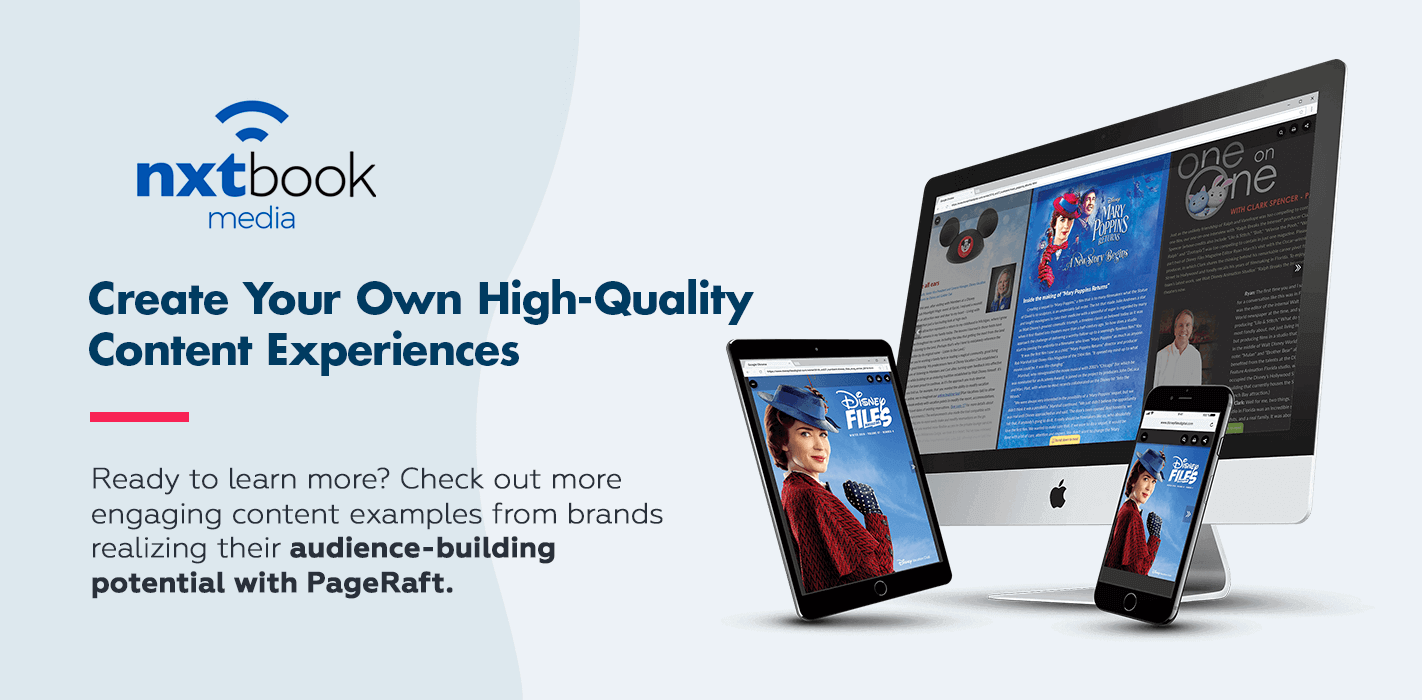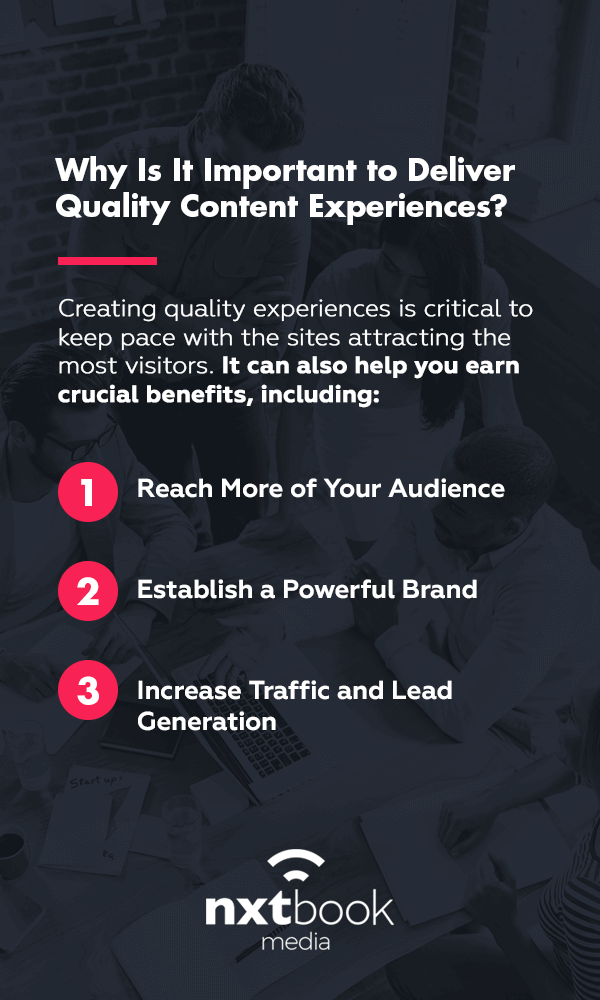5 Examples of Engaging Content Experiences

Written by Matt Berringer
August 3, 2022
Most marketing managers recognize the power and potential of content marketing. With its ability to help you climb search engine rankings and answer your customers’ toughest questions, a content marketing strategy is crucial. Seeing examples of content experiences that have engaged customers is a great way to start ideating new ideas of your own.
Today’s savvy marketers know results encompass more than the article or video itself getting noticed in the sea of media vying for the top spots on Google and sticking in customers’ minds. Top-quality content focuses on user experience (UX). Leaving an impact with your target audience requires stellar content delivered in an engaging format to develop an experience worth coming back to.
Learn more about:
What Are the Components of a High-Quality Content Experience?
Knowing how to create engaging content for today’s audiences requires a firm handle on your content environment. Some signs of effective UX content strategy and experience management include content that:

1. Delivers Beautiful Design
Great design makes your content more professional and appealing. People prefer to engage with visually appealing content for many reasons. First, attractive design is easier to read. High-contrast color schemes and readable fonts can boost your user experience because readers don’t have to zoom in or squint to read. Visual elements can even drive readers to read more of your content by breaking up large text blocks. Infographics and heading design can also aid viewers’ understanding.
While cluttered design might make users’ eyes gloss over, a sharp, simple layout makes the critical information jump out. It captures your audience’s attention and keeps them reading.
Content with a great user experience looks appealing on any device. Usually, designers and marketers create on giant screens and multi-monitor setups. While this makes it easier to dive into the details, it’s also easy to forget how most users will ultimately experience your publications. Approximately 58% of all web traffic comes from mobile users. With a need for visually stunning, mobile-friendly layouts, you must use content publishing solutions with responsive design.
2. Simplifies and Clarifies the User Experience
Attractive design goes hand-in-hand with usability. Simple structures and layouts make it easier for users to engage with your content. Delivery has a massive impact on user experience. To cultivate an enjoyable user experience, logically organize the content itself.
Set stringent content requirements that prioritize UX in the layout and design choices. Think about the information your readers want, and make it readable and easy to understand. Avoid distractions, such as pop-up ads, that prevent users from finding what they want. Make your content platform easy to navigate with an intuitive layout.
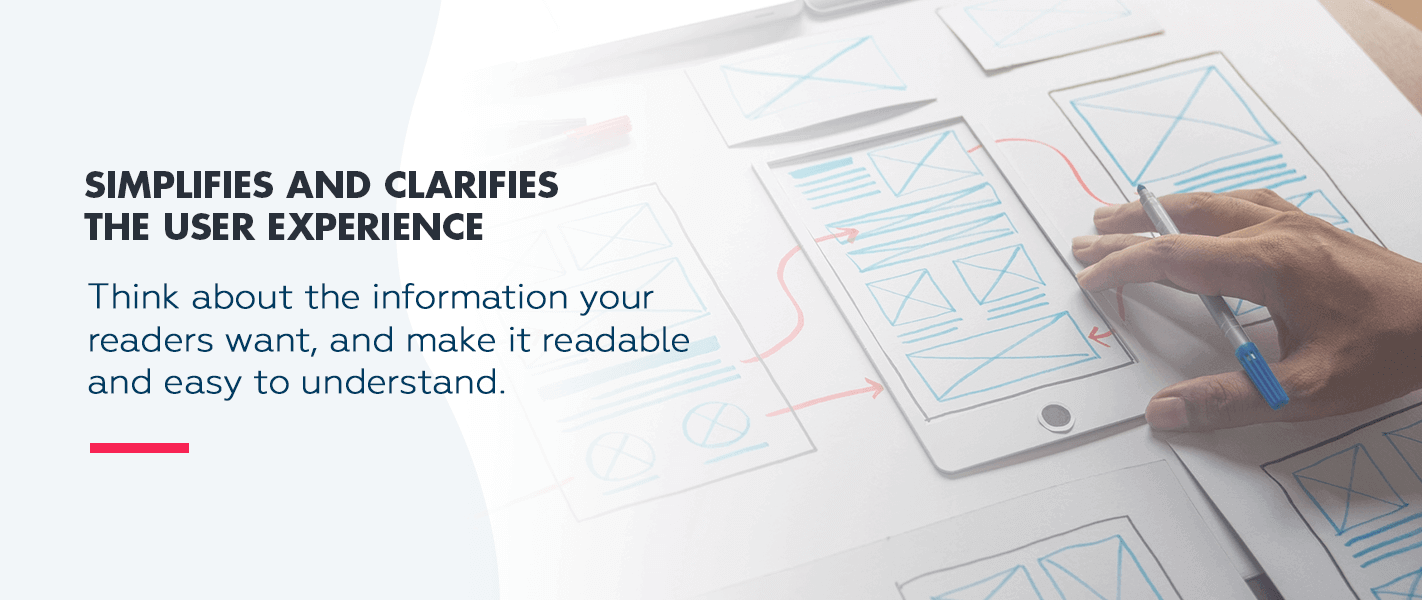
It’s also crucial to curate by relevance. Consider how a user with a particular pain point might want to learn about a topic. Group similar topics together so your users can find what they need quickly. Link to related articles within each post. Ensure all your content has an enjoyable format and offers variety to engage audiences who prefer different formats. For instance, you might include downloadable versions of web-based content.
3. Personalizes the Messaging and Creates a Relationship
Content with a good user experience speaks to a targeted audience and delivers hyper-relevant content. Personalization is more than an effective marketing tactic. For the 61% of people who expect brands to tailor their experiences, it’s a requirement.
The best way to write engaging content is to focus on your target audience. For any brand that needs to engage multiple audiences, it is crucial to create separate content geared toward each. That means developing audience personas based on market segments to guide creation. Speak to at least one persona in every piece you produce.
Another aspect of content experience is personalizing the environment surrounding your content. If you’re collecting the right data about your website visitors, you can ensure you’re suggesting the right content to them. For example, if one of your repeat visitors has already downloaded a gated whitepaper, driving that visitor back to the download page is a waste of time. Instead, deliver content to guide particular users further down the sales funnel based on their previous viewing history.
4. Engages Readers Into Action
Engaging content convinces readers to take the next step. For a customer early in the discovery process, the next step is to dive deeper into the research process. Here, your videos and articles should drive audiences to consume more relevant content. The copy should link to other sources revolving around the same topics. Depending on the format, consider more ways to suggest content. You could include a sidebar or bottom section for relevant posts. The end of a video is the perfect place to highlight related videos.
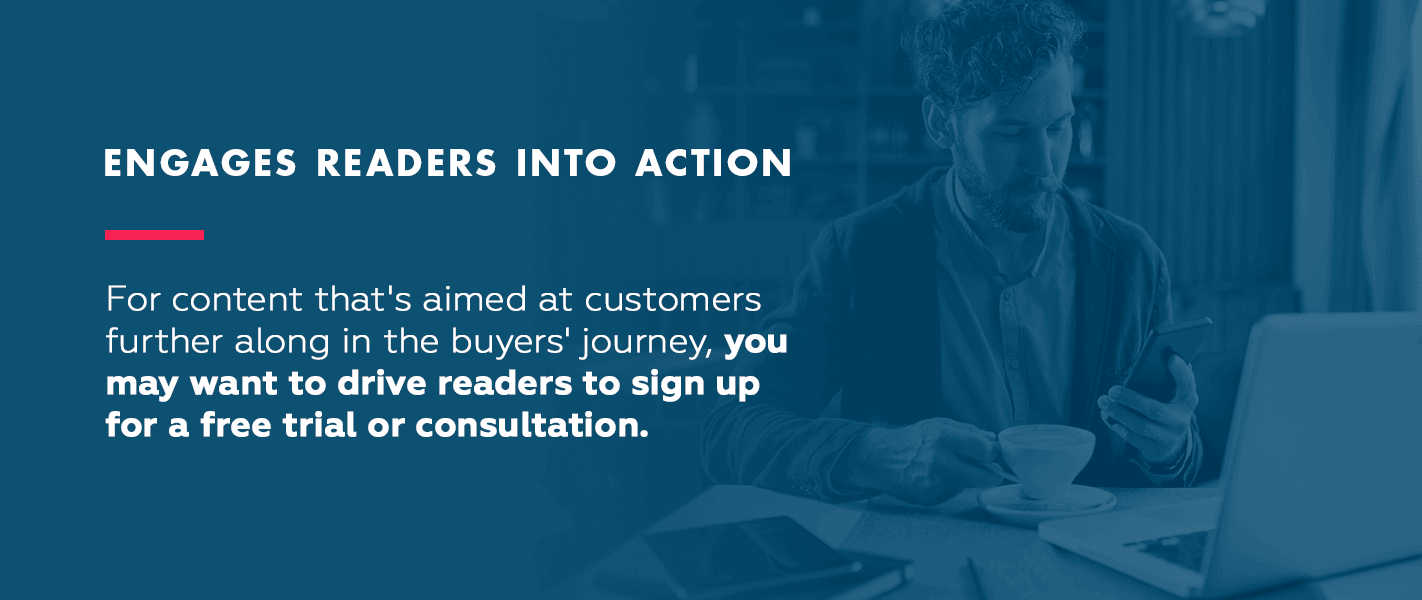
For content that’s aimed at customers further along in the buyers’ journey, you may want to drive readers to sign up for a free trial or consultation. It’s essential to optimize this content for conversions and lead generation. While there are many ways to do this, something as simple as adding a call to action (CTA) button can dramatically improve your user experience. Adding a single CTA button to an email can increase clicks by 371% and sales by 1,617%.
Engaging Content Experience Examples
Our research indicates four key elements to effective user interface (UI) design — intuitiveness, simplicity, attractiveness and responsive design. Brands can achieve these characteristics in their content presentation in many ways. The key is finding the format that works best for your targeted audience and the particular content you’re publishing. Catalogs to sell a product may look different from content that contributes to brand image or offers helpful advice to readers. One strategy many brands use to tailor an immersive content experience is to move beyond traditional PDFs for their publications. Interactive magazines, booklets, product catalogs and brochures are proven to provide a superior UI.
With more design flexibility, such as video, animation and slideshow integration, interactive media is more attractive than traditional PDFs. Buttons and links become instantly clickable, and pages follow a familiar scrolling mechanism in both left-to-right and up-and-down movement. These elements build on the publication’s intuitive interface and simple design. Unlike static PDFs, these formats are responsive, meaning they automatically resize themselves to the size of any screen. Readers get a beautiful experience no matter how they interact with the content — no pinching required. Brands can ensure brand consistency through a controlled viewing experience.
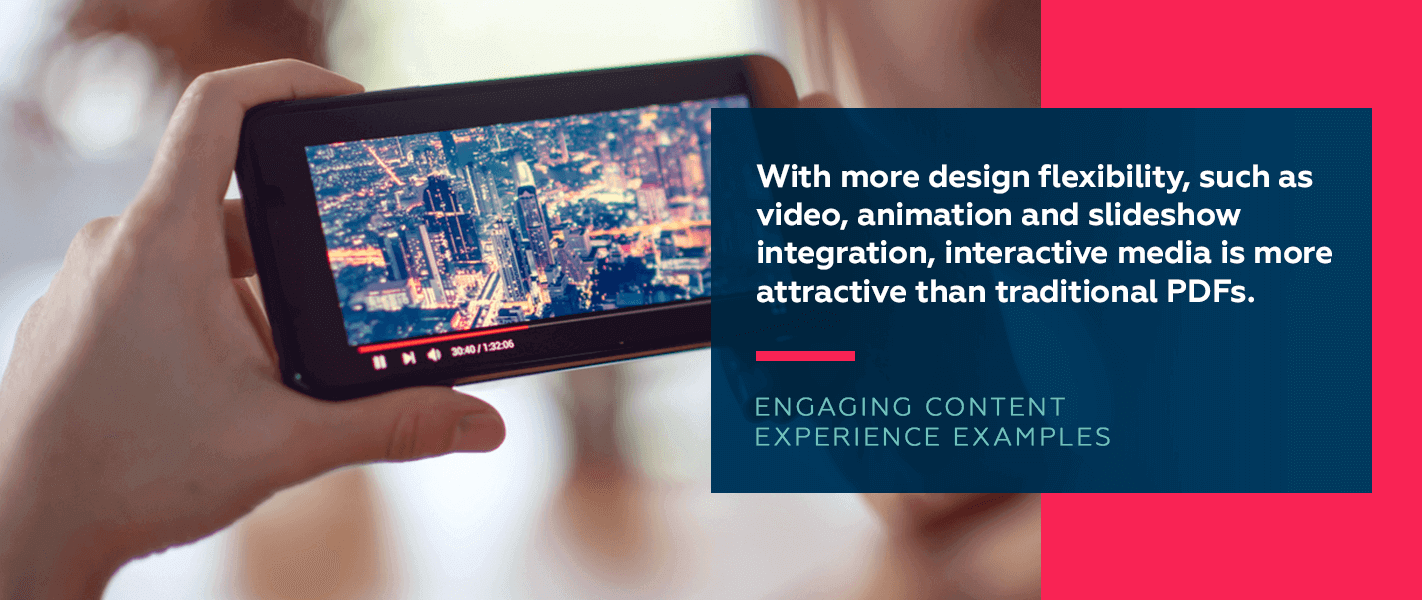
With all the possibilities for designing an impactful digital experience, it’s helpful to look at the best examples. Here are five content experience case studies across multiple industries from brands delivering world-class digital experiences:
1. RoadPro’s Digital Magazine Speaks to the Audience
The RoadPro family of brands has a simple mission to improve the quality of life for professional truckers on the road. Their digital publication, Trucker Gear Guide, is a blend of editorial content, advertising and engaging videos that integrate smoothly to deliver on that mission.
Their articles focus on topics like cooking, maintenance tips and ways to enjoy life on the road. They’re all written by fellow truck drivers, speaking the same language as their audience. This content is interwoven with ads that are relevant to RoadPro’s audience. The products advertised are tools that make life easier for truckers, from GPS systems and wireless earpieces to maintenance tools for truckers on the go.
The engaging design lets RoadPro’s designs expand to life and practically jump off the page. The liberal use of video breaks up the text and enables truckers to connect with the content in a whole new way. Who better to narrate a quick maintenance tip than an experienced trucker? What better way to introduce a relevant product to the audience than with a targeted video ad? RoadPro has found a fantastic way to reach their particular niche, and they’ve seen remarkable results. They see improved readership response and engagement metrics with every publication.
2. Disney’s Mobile-First Platform Drives Deeper Engagement
As a company delivering vacation experiences and entertainment alike, Disney has content experience down to a science. They understand how to create a meaningful experience through interactive, engaging publication formats.
One of the critical elements of their content delivery strategy is using mobile-first design. Back in 2015, around 30%-40% of internet traffic came from mobile devices. Since 2017, that number has hovered around 50%. In 2019, the average U.S. adult spent 3 hours and 43 minutes on their mobile device each day. Today’s content needs to cater to the way people consume media.
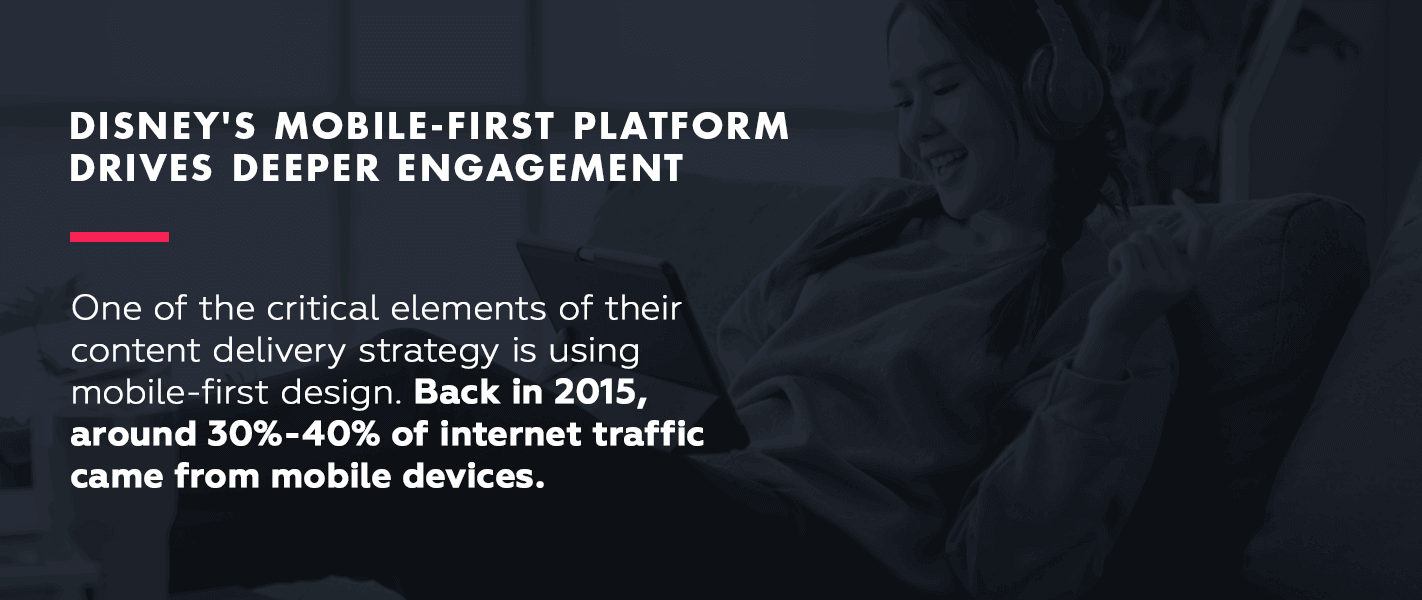
Disney recognized the need for mobile-first design for their exclusive publication, Disney Files, available to Disney Vacation Club members. Before fall 2018, Disney delivered their quarterly magazine using a digital PDF. The PDF publication was unresponsive, meaning it didn’t adjust to various screen sizes. The brand also needed a way to boost engagement and stand out among the other content competing for their audience’s attention. They switched to an interactive digital publication to design meaningful digital experiences with their audience.
The publication is responsive, meaning it reflows to fit any browser window size or mobile device. It provides easy navigation, letting viewers easily pop out images without pinching their screens. The new design engages the average Disney Files reader for 6 minutes per session.
3. Garmin’s Curated Digital Booklet Increases Click-Thru Rates
Another key to content experience is packaging it in the most user-friendly way. Even if your brand lists key information on its website, it often makes sense to repackage it in other formats to engage more users in the way they prefer to consume media. That’s what Garmin did with their targeted digital product catalog for the Forerunner and fenix series products.
The publication repackaged and condensed the product information about their wearable tech to build a lively digital experience targeted at runners. The magazine brought the products to life by telling the story and purpose for each product. A reader could instantly see which products were best for their lifestyle. It laid out a selection of products for “the teammate,” “the mentor” and “the expert.” It allows readers to visualize exactly how particular products might improve their life beyond what they could from an e-commerce page with product specs.
The digital booklet interweaves flippable pages, videos and links to the website to create a seamless, engaging video experience. The results were upwards of 3 minutes of engagement per session and close to 100% page viewership. Garmin has achieved anywhere from an impressive 7%-50% click-thru rate for each of their digital booklets.
4. Norwegian Cruise Lines Uses Digital Brochures to Connect to Stakeholders
Brochures are a staple of the travel industry, and Norwegian Cruise Lines has found success bringing their travel brochures to the digital sphere. All Norwegian travel brochures integrate seamlessly with their website. When a reader sees an experience they like, they can click on a link to bring them right to Norwegian’s booking page. The company has big plans to expand their digital brochures into an app for travel agents, allowing them to call forth up-to-date marketing materials at the drop of a hat.
Like most brands, Norwegian has several audiences their content must speak to. No matter how many audiences need to connect with their messaging, a more engaging, interactive format will come in handy. Digital travel brochures are an easy win, and Norwegian takes their digital marketing to the next level with engaging stewardship reports to engage their investors and corporate responsibility partnerships.
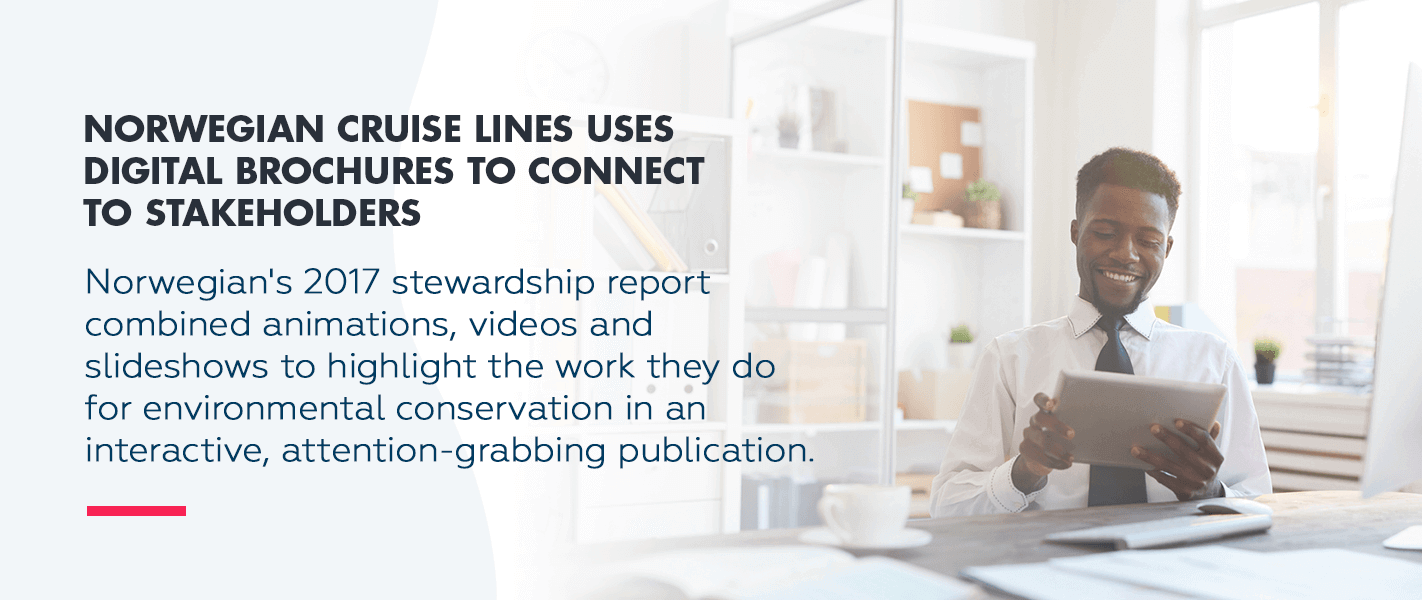
Norwegian’s 2017 stewardship report combined animations, videos and slideshows to highlight the work they do for environmental conservation in an interactive, attention-grabbing publication. They could simultaneously demonstrate their positive impact to employees, shareholders and customers in a multi-media experience any viewer could connect with. A digital magazine was the perfect format for this content. It allowed them to spread their message without printing physical copies, thus reducing waste.
5. Virgin Media’s Creative Content Experience Increases Readership
Virgin Media Ireland’s Play Magazine is a testament to the power and innovation possible with digital content and curated experiences. The quarterly edition is a highly engaging entertainment-centric magazine curated especially for their customers. As a report highlighting all the fun things customers can do with Virgin Media’s connectivity, this publication must be an enjoyable read.
The brand ensured just that with curated entertainment recommendations and integrated video trailers. Readers can find their next binge-watching marathon or e-book beach read and access an exciting trailer or related video with the tap of a play button. They can also navigate the company’s social media pages right from the content.
The digital magazine is jam-packed with entertainment news, contests and company updates for their customers. It has an intuitive scrolling function that lets users turn left to right to browse eye-catching headlines and scroll up and down to read the content that interests them most. Its responsive design engages customers on desktop and mobile alike.
The proof of Virgin Media’s ability to curate the best possible integrated digital experience is in the results. After switching to an integrated digital format, Play Magazine saw an incredible 175% jump in unique viewers and a 186% bump to their open rate. Their readers spent an average of 50% more time engaging with the content.
What Is Content Experience?
Think of content experience as the packaging surrounding your content. Consider how beautiful, thoughtful package design can tempt you to buy that new brand of granola bars at the grocery store. Content experience is similar. It makes your audience want to read or engage further. The content experience begins with the context and how it reaches your audience. It also encompasses how the content is structured and how it engages your customers. It necessitates snappy writing with a strategy for how to feed it to your audience.
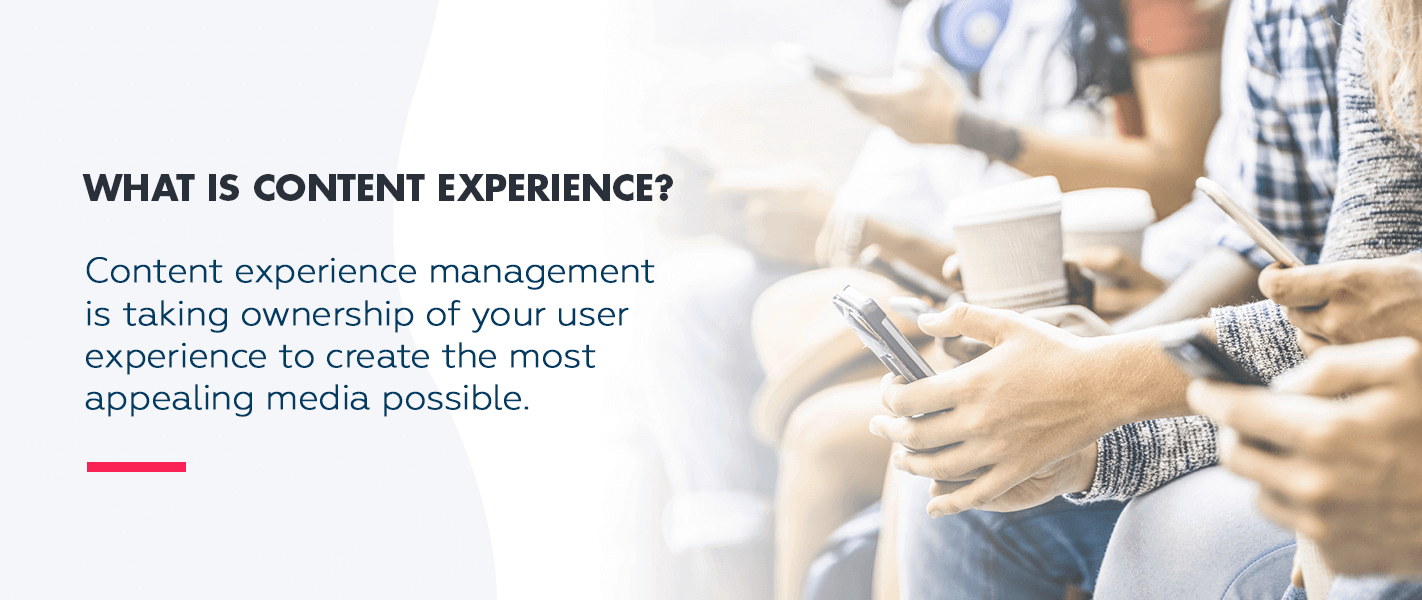
Any content you publish has a content experience. Are you delivering the best UX content possible? Content experience management is taking ownership of your user experience to create the most appealing media possible. We’ve compiled some engaging content ideas from brands who’ve perfected their user experience content strategy.
Why Is It Important to Deliver Quality Content Experiences?
The average U.S. consumer spent 6 hours and 35 minutes interacting with digital media every day in 2019. Americans spend so much time online for one simple reason — it’s enjoyable. Content that delights people is taking up the majority of people’s free time. Music, video streaming and social media are addictive because media sites have perfected their UX.
Your audience spends a significant amount of time online, and good UX and branding set their expectations. Creating quality experiences is critical to keep pace with the sites attracting the most visitors. It can also help you earn crucial benefits, including:
1. Reach More of Your Audience
Search engine optimization (SEO) is powerful because it finds users when they’re actively searching. Your customers are looking for answers you can provide. If your advice ranks highly on search engines, you can introduce these customers to your brand. It’s great for user experience because SEO content is conversational and makes it easy for users to find the answers they need.
Focusing on the content experience alongside SEO can improve your visibility and let you reach more customers.
2. Establish a Powerful Brand
The level of effort you put into your content will shine through and reflect your brand. With brands producing media on any and every channel, it’s not enough to simply create content. Cutting through the noise requires a focus on how users experience your content. Prioritizing high-value content that’s easy and enjoyable to read will boost your credibility. It gives you a mouthpiece and connects with your customers without feeling pushy or salesy. When you consistently rank in search results, you can become the go-to resource in your industry. When your content becomes known for delivering the most value, knowledge and satisfaction, you’ll gain even more loyalty.
Learn more about branding:
- Starting a Brand Audit
- Brand Recall & Time Engaged
- Developing a Digital Brand Strategy
- What Comes After A Brand Audit
3. Increase Traffic and Lead Generation
Content experience is as much about distribution as it is the publications themselves. If you deliver content where your audience most wants to see it, you can instantly boost traffic to your website.
Distributing content that’s optimized for particular environments can also increase traffic. For example, you’ll probably post different content on LinkedIn than you do on Facebook. The information sent to your email subscribers won’t look like what you deliver to people unfamiliar with your brand.
Once you bring in traffic to your content, you can keep them returning by delivering a fantastic user experience. Your audience is more likely to return to good UX, and they may be quick to bounce with bad UX. Once you increase your traffic, great UX can also enhance lead generation. Well-designed, UX-friendly websites can boost conversion rates by up to 400%. Since prioritizing user experience produces targeted content, your leads may be higher quality and more relevant.
Create Your Own High-Quality Content Experiences
Digital publications can be so much more than a flat PDF. Turn your next edition into an interactive content experience with Nxtbook Media. Our PageRaft software lets you design engaging, responsive experiences that fill the page on any device. Animate text, make photos expandable and accessible, embed video content and more. It’s the perfect solution to publish whitepapers, original research, brochures, catalogs, e-books, magazines and other beautiful, highly engaging marketing collateral.
Our browser-based bundled content lets you share your content anywhere or set up gated materials for lead generation. It lets you create content with a clear beginning and end, and the final product won’t be surrounded by distracting ads or glitchy e-reader applications. Unlike PDFs, it also offers a host of analytics to let you analyze your audience’s behavior. Instantly see where your content gets shared and where users focus their attention. As an experienced digital publication team, we can even help you design your publication to maximize engagement.
Ready to learn more? Check out more engaging content examples from brands realizing their audience-building potential with PageRaft. To see the platform in action, schedule product a demo today.
